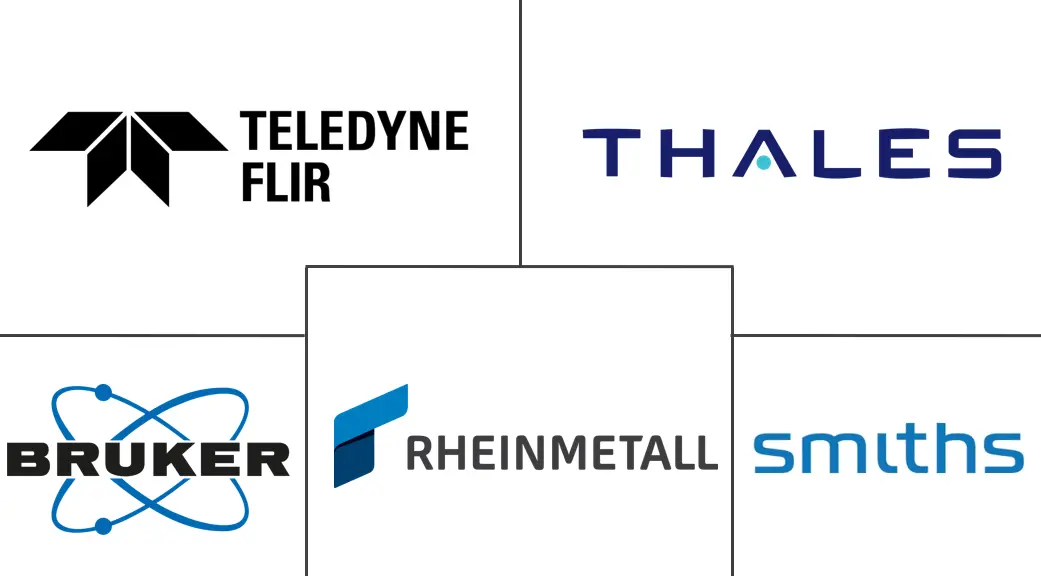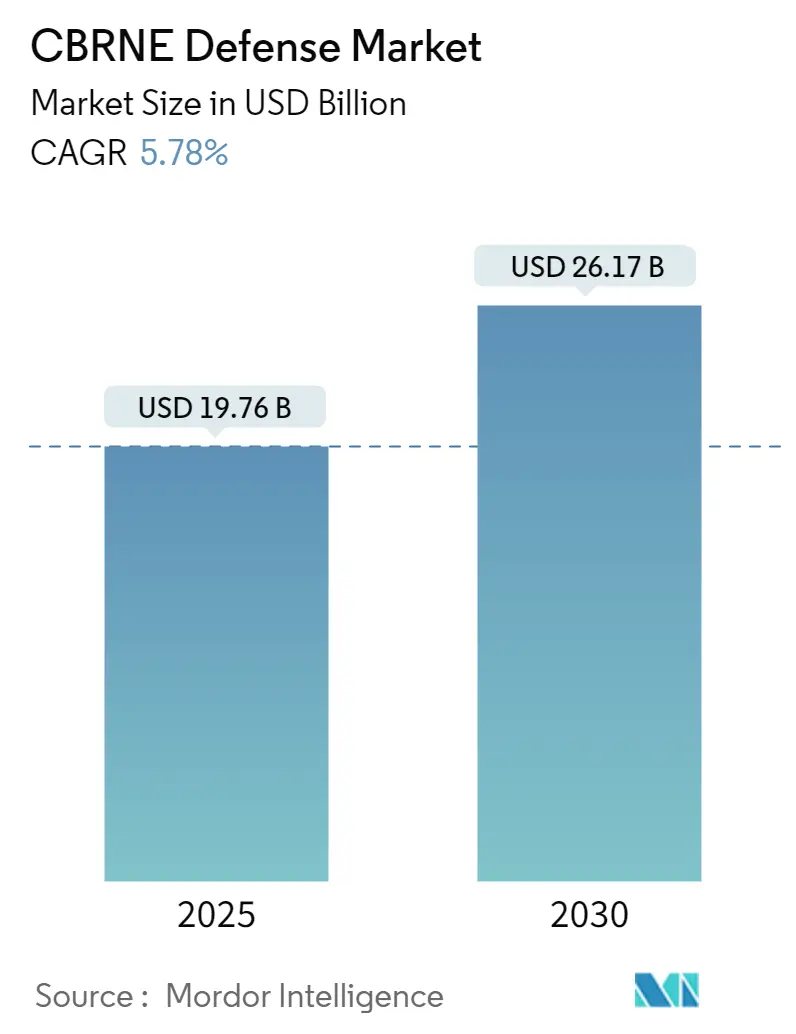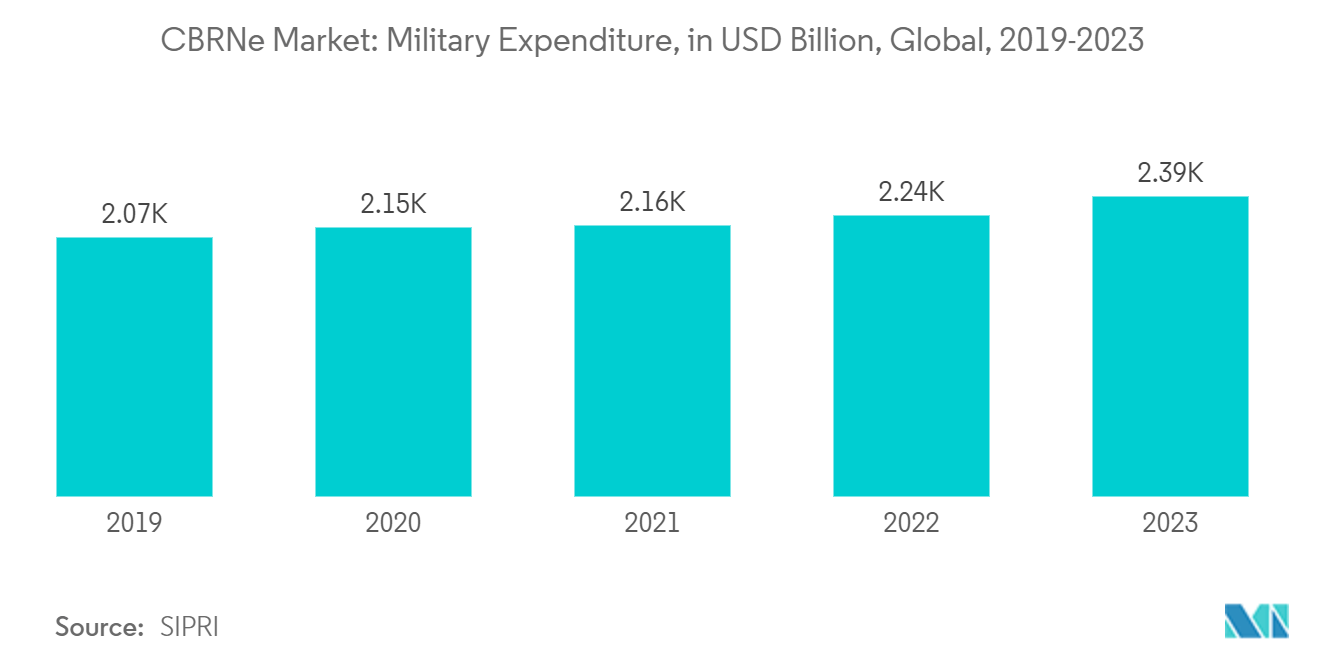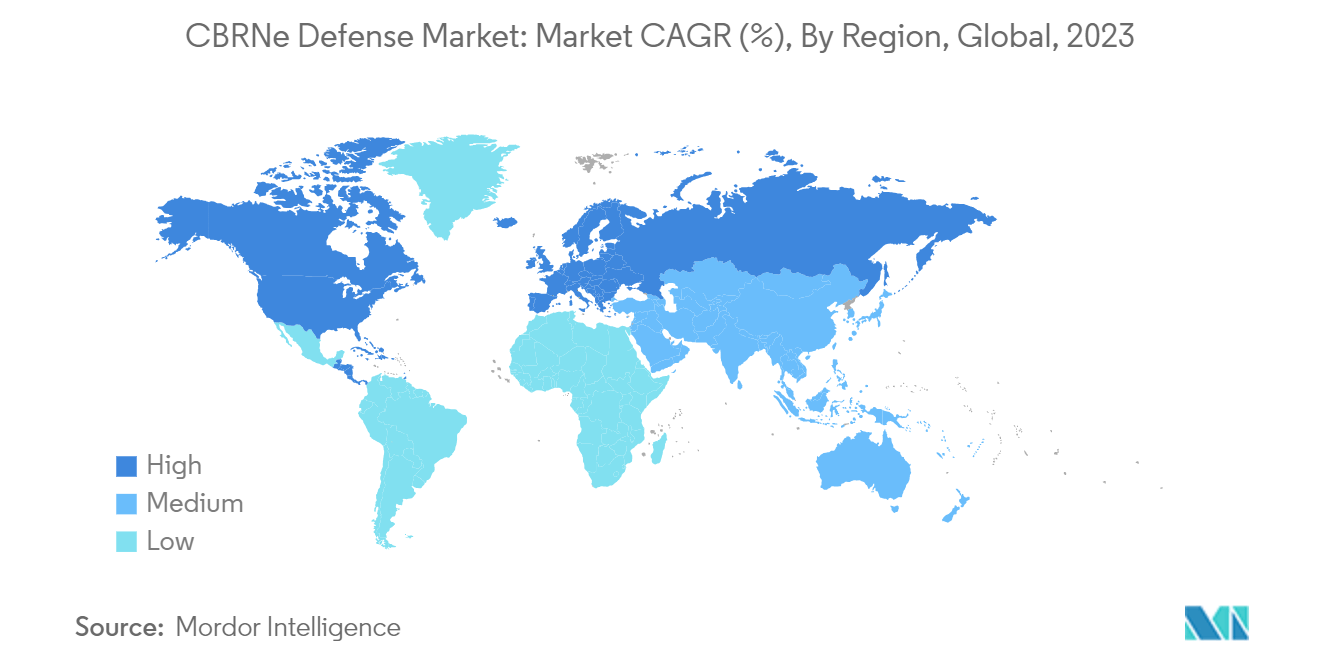CBRNe Defense Market Analysis
The CBRNE Defense Market size is estimated at USD 19.76 billion in 2025, and is expected to reach USD 26.17 billion by 2030, at a CAGR of 5.78% during the forecast period (2025-2030).
The CBRNe defense market is growing with an increase in the number of terrorist attacks worldwide using CBRNe agents. The increase in the number of threats, as well as attacks carried out by making use of chemical, biological, and radioactive weapons, in recent years, has led to various governments increasing their security measures globally.
Additionally, the CBRNe defense market is driven by higher government investments in defense and homeland security. Governments worldwide are investing heavily in arming their military and civil defense forces with sophisticated CBRNe protective gear and detection systems. Further, research and developmental activities that aid in improving detection accuracy and response times also help the market's growth with the development of real-time monitoring systems and portable detection devices.
However, certain constraints may stagnate the CBRNe market's growth. The costly development and deployment of sophisticated CBRNe detection and protection systems constitute one of the most significant challenges to the market. Several government bodies and organizations may be unable to afford large-scale investments in comprehensive CBRNe solutions. Also, the complexities in the regulations that control the use and distribution of CBRN technologies are resulting in the market expanding slowly. Very high safety and operational standards require a tremendous amount of time and resources for compliance, which is a hurdle to the market entry of new players.
CBRNe Defense Market Trends
The Military Segment to Dominate the Market During the Forecast Period
The military segment currently dominates the market and is expected to continue its dominance during the forecast period. With growing threats from terrorists and a rise in political tensions, CBRNe weapons have emerged as a potential threat to several countries.
Government programs are one of the critical drivers of CBRN market growth in the military segment. Both national and international programs are directed toward enhancing CBRN defense capabilities. For instance, the EU’s Joint Chemical, Biological, Radiological, and Nuclear Defence Centre of Excellence encourages collaborative studies between the European Union’s member states. Likewise, national programs like those in the United States focus on advanced scientific research and technology development to improve military readiness against CBRN threats. The mentioned factors boost the growth of this market since innovations are nurtured while present defense systems are enhanced.
Additionally, the focus is on protecting military personnel against vulnerable attacks. For instance, in February 2024, Avon Protection launched the EXOSKIN-S1 CBRN protective suit. The newest CBRN protective suit is a significant development in high-level protection provisions for people facing CBRN hazards. The EXOSKIN-S1 has integrated advanced materials and innovative design features to provide optimum protection against hazardous agents.
These vehicles can monitor hazardous airborne agents over long distances and transmit a CBRN warning through a military communications line. Moreover, many investments are being made in the R&D of devices and equipment to counter CBRN threats, which is expected to drive the segment during the forecast period.
North America Anticipated to Witness the Highest Market Growth During the Forecast Period
The North American market is expected to grow during the forecast period. The majority of demand for CBRNe defense systems in North America is generated from the United States, which has formulated a National Strategy for CBRNe Standards, mainly for the coordination, prioritization, establishment, and implementation of CBRNe equipment standards. The country is also significantly investing in the development of CBRNe defense systems.
For instance, in January 2024, the US DoD awarded Draper a USD 26 million contract to develop CBRN reconnaissance systems. The contract is specifically focused on improving unmanned CBRN missions. Draper will integrate sophisticated flight software and sensor-driven algorithms, as well as the capability to execute collaborative missions and fly without GPS use. This development will be meant to protect operators and will interface with the command-and-control system of the US Army’s Nuclear, Biological, and Chemical Reconnaissance Vehicle Stryker platform.
In addition, under the Man Transportable Robotic System Increment II (MTRS Inc II), the US Army is acquiring unmanned ground vehicles to support engineers, chemical, biological, radiological, and nuclear (CBRN) soldiers, and special operations forces. The new UGVs are replacing the aging non-standard fleet of robots for locating, identifying, and clearing landmines, unexploded ordnance, and improvised explosive devices, which may enhance the maneuverability and survivability of military personnel. Investments in developing and procuring CBRNe defense equipment in North America are expected to propel market growth during the forecast period.
CBRNe Defense Industry Overview
The CBRNe defense market is fragmented, with several players accounting for minor shares in the global market. The prominent players in the market include Rheinmetall AG, Smiths Group PLC, Bruker Corporation, Teledyne FLIR LLC, and THALES. In line with the increasing global demand, several companies have collaborated with research laboratories and institutions to develop advanced defense equipment or devices.
For instance, in October 2023, the UK Ministry of Defence awarded a contract to Smiths Detection, valued at USD 111.76 million, to develop next-generation Chemical Sense Equipment after a competitive tendering process. The program will enhance the MoD's capabilities in chemical detection and protection against toxic chemicals. Smiths Detection will develop three advanced chemical sensor products: wearable personal sensors with vapor and aerosol capabilities, a portable survey sensor for hazardous locations, and a remote monitoring sensor for fixed locations.
Investments in advanced robotic technologies (integrated advanced sensors and payloads for conducting CBRNe missions) and strategies, such as building trust with stakeholders, lowering product costs, and increasing product awareness, are expected to drive the growth of market players during the forecast period.
CBRNe Defense Market Leaders
-
Teledyne FLIR LLC
-
Smiths Group plc
-
Thales Group
-
Bruker Corporation
-
Rheinmetall AG
- *Disclaimer: Major Players sorted in no particular order
CBRNe Defense Market News
May 2024: Norway was awarded a seven-year framework contract by Finland’s Bertin Environics for developing chemical, biological, radiological, and nuclear (CBRN) defense squad kits. Under this contract, Bertin Environics will supply an undisclosed number of ChemProX handheld chemical detectors and SaphyRad MS multiprobe radiation survey meters. These devices are intended for detecting and monitoring chemical warfare agents and toxic industrial chemicals and materials in field operations. Additionally, the detectors will be supplemented with analog detection papers and custom-designed marking kits to enhance operational capabilities. This contract underscores the importance of advanced CBRN detection technologies in national defense strategies.
October 2023: Thales and Bertin successfully conducted government trials on sampling and identification of biologicals as part of the PIABC PELICAN project funded by France's Defence Innovation Agency and led by the DGA's NBC management unit.
August 2023: Bharat Electronics Limited developed and delivered a customized Chemical Biological Radiological Nuclear Hazardous Material Vehicle, CBRN HAZMAT Vehicle, for the National Disaster Response Force (NDRF). The project was completed well ahead of its scheduled time frame and reflected BEL's commitment to the Make in India and Atmanirbhar Bharat initiatives.
June 2023: Kromek Group PLC was awarded a USD 1.5 million contract in the civil nuclear market that is expected to be delivered over 15 months. The contract awarded by an Asian distribution partner is for the delivery of a new product to three end customers within that territory. Based upon its extant technology and fully funded by the distribution partner, this new product has been developed for use in civil nuclear. In that respect, it detects, identifies, and analyzes radiological sources while adding to the institutional safety and monitoring capabilities of nuclear facilities.
February 2023: Teledyne FLIR Defense, a division of Teledyne Technologies Incorporated, secured a USD 13.3 million contract from the US Department of Defense to enhance the R80D SkyRaider unmanned aerial system (UAS) for autonomous chemical, biological, radiological, and nuclear (CBRN) reconnaissance missions. This contract involved integrating flight control software for autonomous CBRN missions, reducing the need for soldiers to manually carry detection sensors into hazardous zones. Additionally, Teledyne FLIR plans to develop prototype chemical and radiological sensor payloads and integrate existing US Army detectors.
CBRNe Defense Industry Segmentation
Chemical, biological, radiological, and nuclear threats have collectively come to be known as CBRNe threats, and the actualization of the threats as CBRNe incidents. These include attacks using NBC weapons, otherwise called weapons of mass destruction (WMD). Chemical, biological, radiological, nuclear, and explosives defense includes protective measures taken in situations where hazards such as chemical, biological, radiological, or nuclear warfare (including terrorism) may be present. CBRNe defense consists of CBRNe passive protection, contamination avoidance, and CBRNe mitigation.
The market is segmented by purpose, application, and geography. By purpose, the market is segmented into detection, protection, decontamination, and simulation and training. By application, the market is segmented into military and civil and law enforcement. The report also covers the sizes and forecasts for the CBRNe market in major countries across different regions. For each segment, the market size is provided in terms of value (USD).
| Purpose | Detection | ||
| Protection | |||
| Decontamination | |||
| Simulation and Training | |||
| Application | Military | ||
| Civil and Law Enforcement | |||
| Geography | North America | United States | |
| Canada | |||
| Europe | United Kingdom | ||
| Germany | |||
| France | |||
| Italy | |||
| Rest of Europe | |||
| Asia-Pacific | China | ||
| India | |||
| Japan | |||
| South Korea | |||
| Rest of Asia-Pacific | |||
| Latin America | Brazil | ||
| Mexico | |||
| Rest of Latin America | |||
| Middle East and Africa | Israel | ||
| United Arab Emirates | |||
| Saudi Arabia | |||
| Rest of Middle East and Africa | |||
Chemical, Biological, Radiological, Nuclear and Explosives (CBRNe) Defense Market Research FAQs
How big is the CBRNE Defense Market?
The CBRNE Defense Market size is expected to reach USD 19.76 billion in 2025 and grow at a CAGR of 5.78% to reach USD 26.17 billion by 2030.
What is the current CBRNE Defense Market size?
In 2025, the CBRNE Defense Market size is expected to reach USD 19.76 billion.
Who are the key players in CBRNE Defense Market?
Teledyne FLIR LLC, Smiths Group plc, Thales Group, Bruker Corporation and Rheinmetall AG are the major companies operating in the CBRNE Defense Market.
Which is the fastest growing region in CBRNE Defense Market?
North America is estimated to grow at the highest CAGR over the forecast period (2025-2030).
Which region has the biggest share in CBRNE Defense Market?
In 2025, the North America accounts for the largest market share in CBRNE Defense Market.
What years does this CBRNE Defense Market cover, and what was the market size in 2024?
In 2024, the CBRNE Defense Market size was estimated at USD 18.62 billion. The report covers the CBRNE Defense Market historical market size for years: 2019, 2020, 2021, 2022, 2023 and 2024. The report also forecasts the CBRNE Defense Market size for years: 2025, 2026, 2027, 2028, 2029 and 2030.
Our Best Selling Reports
CBRNe Defense Industry Report
Statistics for the 2025 CBRNE Defense market share, size and revenue growth rate, created by Mordor Intelligence™ Industry Reports. CBRNE Defense analysis includes a market forecast outlook for 2025 to 2030 and historical overview. Get a sample of this industry analysis as a free report PDF download.







